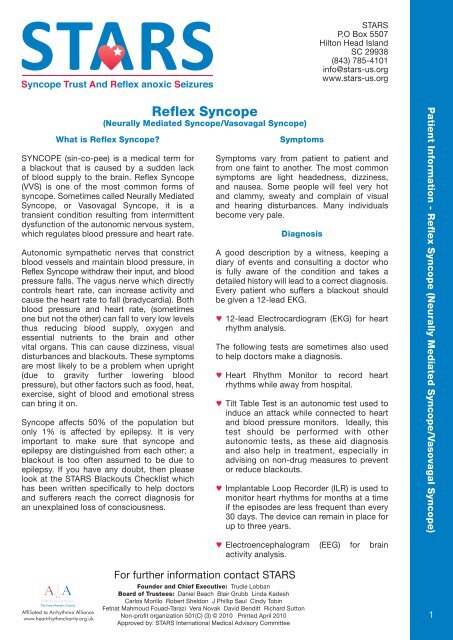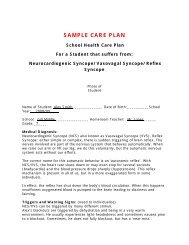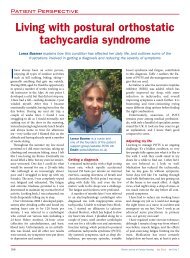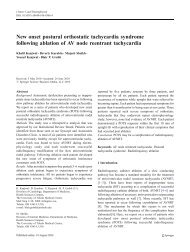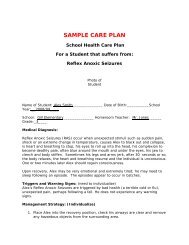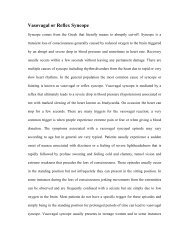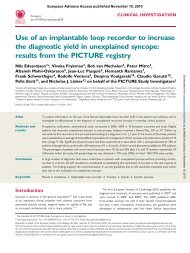STARS REFLEX SYNCOPE (Vasovagal Syncope) US Sheet.indd
STARS REFLEX SYNCOPE (Vasovagal Syncope) US Sheet.indd
STARS REFLEX SYNCOPE (Vasovagal Syncope) US Sheet.indd
- No tags were found...
Create successful ePaper yourself
Turn your PDF publications into a flip-book with our unique Google optimized e-Paper software.
<strong>STARS</strong><br />
P.O Box 5507<br />
Hilton Head Island<br />
SC 29938<br />
(843) 785-4101<br />
info@stars-us.org<br />
www.stars-us.org<br />
Reflex <strong>Syncope</strong><br />
(Neurally Mediated <strong>Syncope</strong>/<strong>Vasovagal</strong> <strong>Syncope</strong>)<br />
What is Reflex <strong>Syncope</strong><br />
<strong>SYNCOPE</strong> (sin-co-pee) is a medical term for<br />
a blackout that is caused by a sudden lack<br />
of blood supply to the brain. Reflex <strong>Syncope</strong><br />
(VVS) is one of the most common forms of<br />
syncope. Sometimes called Neurally Mediated<br />
<strong>Syncope</strong>, or <strong>Vasovagal</strong> <strong>Syncope</strong>, it is a<br />
transient condition resulting from intermittent<br />
dysfunction of the autonomic nervous system,<br />
which regulates blood pressure and heart rate.<br />
Autonomic sympathetic nerves that constrict<br />
blood vessels and maintain blood pressure, in<br />
Reflex <strong>Syncope</strong> withdraw their input, and blood<br />
pressure falls. The vagus nerve which directly<br />
controls heart rate, can increase activity and<br />
cause the heart rate to fall (bradycardia). Both<br />
blood pressure and heart rate, (sometimes<br />
one but not the other) can fall to very low levels<br />
thus reducing blood supply, oxygen and<br />
essential nutrients to the brain and other<br />
vital organs. This can cause dizziness, visual<br />
disturbances and blackouts. These symptoms<br />
are most likely to be a problem when upright<br />
(due to gravity further lowering blood<br />
pressure), but other factors such as food, heat,<br />
exercise, sight of blood and emotional stress<br />
can bring it on.<br />
<strong>Syncope</strong> affects 50% of the population but<br />
only 1% is affected by epilepsy. It is very<br />
important to make sure that syncope and<br />
epilepsy are distinguished from each other; a<br />
blackout is too often assumed to be due to<br />
epilepsy. If you have any doubt, then please<br />
look at the <strong>STARS</strong> Blackouts Checklist which<br />
has been written specifically to help doctors<br />
and sufferers reach the correct diagnosis for<br />
an unexplained loss of consciousness.<br />
Symptoms<br />
Symptoms vary from patient to patient and<br />
from one faint to another. The most common<br />
symptoms are light headedness, dizziness,<br />
and nausea. Some people will feel very hot<br />
and clammy, sweaty and complain of visual<br />
and hearing disturbances. Many individuals<br />
become very pale.<br />
Diagnosis<br />
A good description by a witness, keeping a<br />
diary of events and consulting a doctor who<br />
is fully aware of the condition and takes a<br />
detailed history will lead to a correct diagnosis.<br />
Every patient who suffers a blackout should<br />
be given a 12-lead EKG.<br />
♥ 12-lead Electrocardiogram (EKG) for heart<br />
rhythm analysis.<br />
The following tests are sometimes also used<br />
to help doctors make a diagnosis.<br />
♥ Heart Rhythm Monitor to record heart<br />
rhythms while away from hospital.<br />
♥ Tilt Table Test is an autonomic test used to<br />
induce an attack while connected to heart<br />
and blood pressure monitors. Ideally, this<br />
test should be performed with other<br />
autonomic tests, as these aid diagnosis<br />
and also help in treatment, especially in<br />
advising on non-drug measures to prevent<br />
or reduce blackouts.<br />
♥ Implantable Loop Recorder (ILR) is used to<br />
monitor heart rhythms for months at a time<br />
if the episodes are less frequent than every<br />
30 days. The device can remain in place for<br />
up to three years.<br />
Patient Information - Reflex <strong>Syncope</strong> (Neurally Mediated <strong>Syncope</strong>/<strong>Vasovagal</strong> <strong>Syncope</strong>)<br />
The Heart Rhythm Charity<br />
Affiliated to Arrhythmia Alliance<br />
www.heartrhythmcharity.org.uk<br />
For further information contact <strong>STARS</strong><br />
♥ Electroencephalogram (EEG) for brain<br />
activity analysis.<br />
Founder and Chief Executive: Trudie Lobban<br />
Board of Trustees: Daniel Beach Blair Grubb Linda Kadesh<br />
Carlos Morillo Robert Sheldon J Phillip Saul Cindy Tobin<br />
Fetnat Mahmoud Fouad-Tarazi Vera Novak David Benditt Richard Sutton<br />
Non-profit organization 501(C) (3) © 2010 Printed April 2010<br />
Approved by: <strong>STARS</strong> International Medical Advisory Committee<br />
1
<strong>STARS</strong><br />
P.O Box 5507<br />
Hilton Head Island<br />
SC 29938<br />
(843) 785-4101<br />
info@stars-us.org<br />
www.stars-us.org<br />
Immediate action in the event of a syncopal attack:<br />
The second you feel your usual symptoms coming on:<br />
1. If symptoms are mild or you are unable to sit or lie down, cross your ankles and tense your<br />
calf muscles tightly. Combine this movement with buttock clenching to make effects more<br />
pronounced (this will help to get the blood pumping around your body and increase your<br />
blood pressure so relieving symptoms).<br />
2. If you are able, sit down IMMEDIATELY or, if possible LIE DOWN FLAT AND PUT YOUR<br />
LEGS IN THE AIR - for example against a wall or propped up on pillows, and if you can it is<br />
preferable to do a cycling movement with your legs.<br />
3. SQUAT if you are unable to lie down.<br />
4. Don’t try to fight your symptoms; you are not stronger than your blood pressure, and it will win!<br />
5. GET UP CAUTIO<strong>US</strong>LY when you feel well again. Slowly sit up and gradually stand up.<br />
If symptoms continue, promptly repeat immediate action steps.<br />
Reflex <strong>Syncope</strong> is also known as:<br />
Neurally Mediated <strong>Syncope</strong><br />
<strong>Vasovagal</strong> <strong>Syncope</strong><br />
Common Benign Fainting<br />
Malignant <strong>Vasovagal</strong> <strong>Syncope</strong><br />
Emotional Fainting<br />
Patient Information - Reflex <strong>Syncope</strong> (Neurally Mediated <strong>Syncope</strong>/<strong>Vasovagal</strong> <strong>Syncope</strong>)<br />
The Heart Rhythm Charity<br />
Affiliated to Arrhythmia Alliance<br />
www.heartrhythmcharity.org.uk<br />
For further information contact <strong>STARS</strong><br />
Founder and Chief Executive: Trudie Lobban<br />
Board of Trustees: Daniel Beach Blair Grubb Linda Kadesh<br />
Carlos Morillo Robert Sheldon J Phillip Saul Cindy Tobin<br />
Fetnat Mahmoud Fouad-Tarazi Vera Novak David Benditt Richard Sutton<br />
Non-profit organization 501(C) (3) © 2010 Printed April 2010<br />
Approved by: <strong>STARS</strong> International Medical Advisory Committee<br />
2


